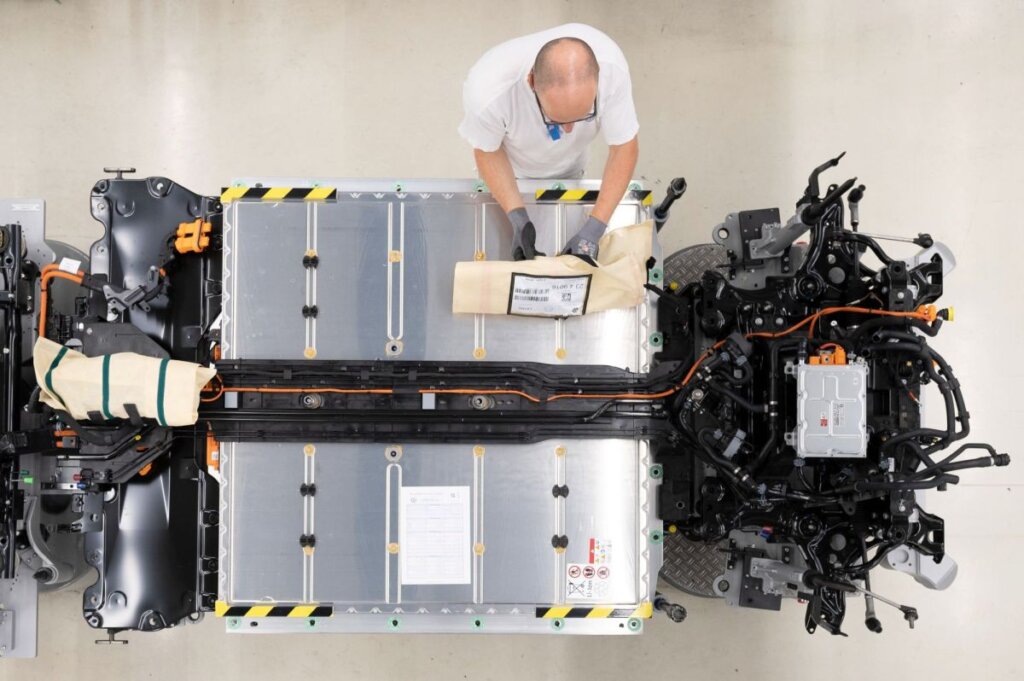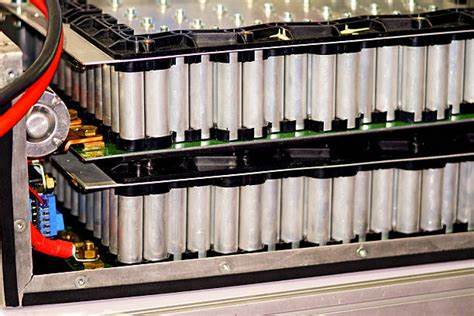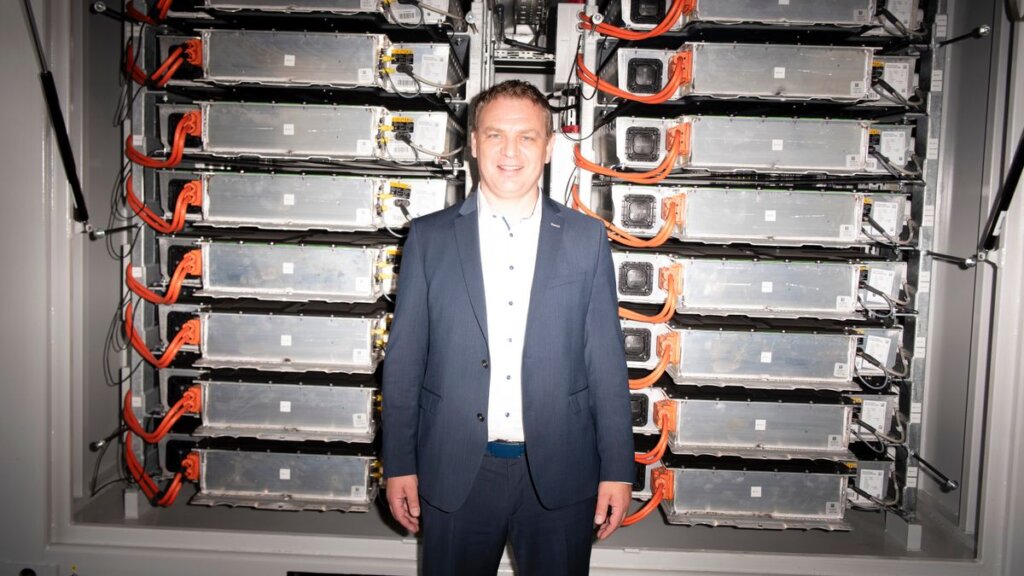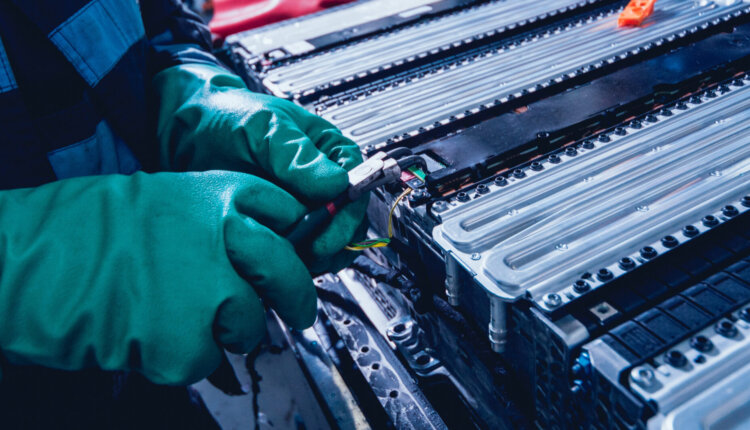Franz-Josef Feilmeier (Fenecon), If the entrepreneur thinks here, with a view of the trees, trampoline and his children playing, then it could be that another piece of the puzzle for the energy transition is being conceived, made in Lower Bavaria.
Feilmeier is the man with vision at Fenecon, a medium-sized manufacturer of electricity storage devices in Deggendorf. The EUPD Research database lists Fenecon among the top ten producers of home storage systems on the German market.
Started as a garage in 2011, Fenecon has recently grown strongly: the workforce has tripled to 300 people since 2020, sales were 92 million euros in 2022, and this year it is expected to be 170 million euros. Also wife Alexandra (37) and brother Stefan Feilmeier (37) are members of the management team. The advantage of a family business? “The unconditional trust,” says Feilmeier.
To date, Fenecon has sold and rented its electricity storage units primarily to private customers who temporarily store energy from photovoltaic systems and refuel their electric cars from charging stations. Fenecon storage units have sophisticated energy management: software proactively controls the charging and discharging of the batteries.
The weather forecast and also the development of electricity prices on the stock exchange are taken into account, explains Feilmeier. Purchases are made at times when there is a lot of cheap renewable energy on the market. Artificial intelligence coordinates purchases and consumption so that there is no need to react ad hoc. “Our claim is: Everything we develop should lead to a world in which we are supplied entirely by renewable energies,” explains Feilmeier.

Fenecon Use surpluses sensibly
While new batteries made of lithium iron phosphate are installed in smaller home and commercial storage systems, Fenecon has created an innovation for large industrial storage systems: it connects dozens of car batteries to form a storage system. The Fenecon mastermind received EU funding of 4.5 million euros for this idea of a CarBatteryReFactory, which will be built at a new production site in Iggensbach, 20 kilometers away, by the end of 2023. The fact that he installs used batteries from electric cars or uses surplus ones is a win-win situation. Vehicle manufacturers are grateful that he takes the batteries from them and integrates them into his container storage systems.
Business economist Feilmeier explains the logic of his business:
Car manufacturers have to pre-produce electric car batteries and often have surpluses. To prevent them from breaking, they have to stay active. And by installing discarded batteries in its storage systems, Fenecon is complying with EU recycling requirements. A battery that has been around for ten years could serve well in the stationary storage for another ten years, and a new one could last up to 20 years.
Fenecon sells the outdoor storage units or rents them out to customers with seasonal needs. Two industrial storage systems are to come off the production line every day the batteries from 40 to 50 electric cars will be recycled. Behind the energy management system called FEMS is an open source platform Fenecon creates interfaces to its system via apps.
OpenEMS (Open Source Energy Management System) is a modular platform designed for energy management, primarily focusing on simulation, optimization, and control of various energy systems. It’s an open-source framework that enables users to model and simulate diverse energy systems such as electrical, thermal, or renewable energy systems.
OpenEMS provides tools and interfaces for integrating different components like batteries, solar panels, electric vehicles, and more, allowing users to analyze and optimize the overall energy flow within a system. It’s useful for researchers, developers, and engineers working on energy-related projects, as it offers flexibility and customization to model different scenarios and optimize energy usage.
The platform supports various communication protocols and interfaces, facilitating the integration of different devices and technologies, making it a versatile tool for energy system analysis and management.
OpenEMS functions as a comprehensive platform that facilitates several key aspects in energy management:
- Modular Framework: OpenEMS is designed as a modular system, allowing users to add, modify, or remove components based on their specific needs. This modular nature makes it adaptable to various energy systems and configurations.
- Simulation Capabilities: It provides simulation tools that enable users to model and simulate different energy systems. Users can create virtual representations of electrical, thermal, or hybrid energy systems, allowing for analysis and optimization without physically implementing the setup.
- Integration of Components: OpenEMS offers interfaces and tools for integrating various components and devices into the system. These could include batteries, solar panels, wind turbines, electric vehicles, and more. This integration allows for a comprehensive view of energy flows and interactions between different elements.
- Optimization and Control: Users can analyze the data and optimize energy flow within a system. This involves managing the distribution of energy, maximizing efficiency, and ensuring optimal utilization of resources. Additionally, it allows for the implementation of control strategies to regulate and manage the energy system.
- Flexibility and Customization: It offers flexibility and customization options to model different scenarios, allowing users to simulate and analyze various configurations and settings. This capability is valuable for researchers, developers, and engineers working on diverse energy-related projects.
- Support for Communication Protocols: OpenEMS supports multiple communication protocols and interfaces, enabling seamless integration with different devices and technologies. This ensures compatibility and interoperability with a wide range of energy-related hardware and systems.
A charging station for electric cars or a heat pump can also be easily connected to the storage system. For example, companies can combine solar energy and charging stations with a commercial storage facility in their parking spaces. A small commercial storage system starts with 30 kilowatts of power. This can be expanded up to 90 kilowatts using additional battery modules as required. “Avoid laying thick cables and get power exactly where it is needed,” advertises Fenecon.
The large industrial storage unit promises 736 kilowatts of power. “Cut load peaks, optimize self-consumption, participate in the energy market” – this is the promise for industrial customers.

Fenecon Breakthrough with stackable battery modules
Many years of technical development go into the products. Today Feilmeier is reaping the benefits. “We put a lot of work into improving the first devices,” he says. The breakthrough came with the stackable battery modules, which run efficiently at high voltage and can be easily connected using plugs. The Fenecon storage units with the drawer principle are easier to transport than complete systems and quicker to install, no IT knowledge is required.
The Chinese company also benefited BYDnow the market leader in home storage Deutschland, from Feilmeier’s developments. He has an intensive history with BYD, also known for its electric cars. As a student he did an internship at MAN in China, at that time an electric bus fleet was advertised for the Olympics in Beijing. MAN lost the competition against BYD. “I’ve followed them a little bit since then,” says Feilmeier.
After studying business administration, he built photovoltaic systems in his uncle’s company and bought the solar modules from BYD in China. As a father Josef Feilmeier In 2011, when he wanted to use solar energy to operate his animal feed warehouse, he needed a power storage system. The stubborn father wanted to remain independent and not feed his electricity into the grid.
Back then, there was no electricity storage system without a connection to the grid. So Franz-Josef Feilmeier founded his own company at the age of 28, had the storage units built by BYD and sold them in Germany. He rented an office in Deggendorf, there was space for testing and development in his father’s garage.
The technical breakthrough came with storage from BYD, which was further developed accordingly. When Fenecon wanted to produce under its own name and concluded contracts with its competitor CATL, BYD withdrew. “It was almost like a broken love,” Feilmeier remembers. Feilmeier could not have imagined how great the need for battery recycling solutions would be among car manufacturers.
The next step in evolution only came about after a request from DHL. Would Fenecon also be able to use used batteries from its e-street scooter fleet in power storage systems? Feilmeier agreed, even though it was new territory. “Suddenly we had to be able to do it.” Belong today BMW and Renault to the customer base.

Don’t be afraid to make political statements
“It sounds stupid, but I’m a yes man” says Feilmeier. For him that means seizing opportunities. When it comes to his core topic, he doesn’t shy away from political debate. He gave a speech at a demo against the Bavarian Economics Minister Hubert Aiwanger (52; Free Voters), who had railed against the federal government and the heating law in front of 13,000 people in Erding.
At election campaign appointments in Aiwanger Lower Bavaria constituency, Feilmeier defended his vision of renewables. He is building a wind turbine at the new Iggensbach location. “The first in the area,” he says proudly. He is a member of the CDU Economic Council and the Green Economic Dialogue, both economic interest groups in Berlin. An FDP Bundestag delegation who believes in the future of nuclear power recently visited him. Feilmeier tried to convince them that electricity from renewable sources was safe, cost effective and clean.

